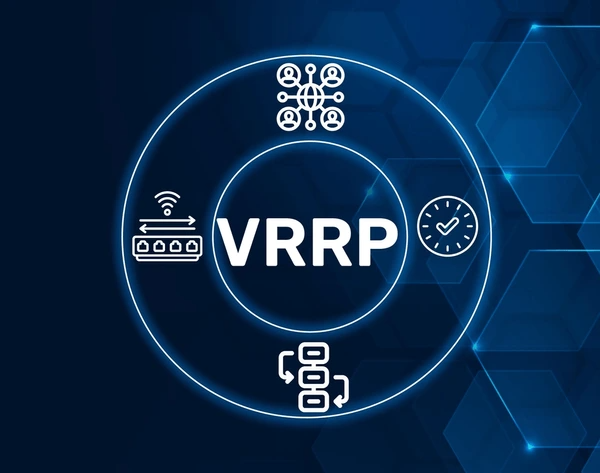
What Is VRRP?
VRRP is a networking protocol designed to provide redundancy and high availability for routers in a network. Its primary purpose is to eliminate the single point of failure inherent in static default routing environments.

How VRRP Works
- Virtual Router: VRRP creates a virtual router, which is an abstract entity managed by the protocol. The virtual router is identified by a Virtual Router Identifier (VRID) and a set of associated IP addresses.
- Master and Backup Routers: Within a VRRP group, one router is elected as the master, while the others act as backups. The master router is responsible for forwarding packets sent to the virtual router’s IP addresses.
- Router Failover: If the master router fails, a backup router is elected as the new master based on a priority scheme. The new master then takes over the virtual router’s IP addresses and continues forwarding traffic, ensuring seamless network connectivity.
- Heartbeat Mechanism: VRRP routers exchange periodic advertisements (heartbeats) to monitor the state of the master router. If the backup routers do not receive advertisements from the master within a specified time, they initiate the failover process.
- Virtual MAC Address: VRRP assigns a virtual MAC address to the virtual router, which is used by hosts on the network as the default gateway. This virtual MAC address is derived from the VRID, ensuring that it remains consistent across failovers.
- Load Balancing: Some implementations of VRRP support load balancing, where multiple routers can simultaneously act as masters for the same virtual router, distributing the traffic load among them.
Key Features of VRRP
Redundancy and Failover
- VRRP allows multiple physical routers to be configured as a single virtual router, with one acting as the master and others as backups.
- If the master router fails, one of the backup routers automatically takes over, ensuring continuous network connectivity and avoiding service disruptions.
Virtual IP and MAC Addresses
- A virtual IP address and virtual MAC address are assigned to the virtual router, which is shared among the physical routers.
- Hosts on the network communicate with the virtual router using the virtual IP address, unaware of the underlying physical routers.
Router Election and Priority
- VRRP routers participate in an election process to determine the master router based on priority levels.
- The router with the highest priority becomes the master, while others act as backups, monitoring the master’s availability.
Seamless Transition
- When a backup router takes over as the new master, it sends gratuitous ARP messages to update the MAC address-to-IP mapping on the network.
- This ensures that hosts continue to communicate with the virtual router without interruption or reconfiguration.
Load Balancing and Scalability
- VRRP supports load balancing by allowing multiple virtual routers to be configured, each with its own virtual IP address.
- This distributes traffic across multiple physical routers, improving performance and scalability.

Benefits of VRRP
- High Availability and Redundancy VRRP provides redundancy for critical routers in the network, ensuring continuity of service in the event of failures. It introduces the concept of a virtual router, associated with a virtual IP address and comprising two or more physical routers (VRRP routers). When the master router fails, one of the backup routers takes over the routing responsibility, forwarding packets sent to the virtual IP address, thus avoiding network disruption.
- Transparent Failover and Failback VRRP failover and failback operations are transparent to end hosts, which communicate with the virtual router without needing to know the physical routers’ addresses. This simplifies network management and eliminates the need to modify host configurations when a failover occurs.
- Efficient Load Balancing VRRP supports load balancing by allowing multiple virtual routers, each with its own virtual IP address. End hosts can be configured to use different virtual routers as gateways, distributing traffic across multiple physical routers.
- Low Overhead and Compatibility VRRP has a low overhead, as it only defines a single packet type (VRRP advertisement) sent by the master router. It is also compatible with various upper-layer protocols, as VRRP packets are encapsulated in IP packets.
Challenges of VRRP
- Delayed Convergence with Dynamic Routing Protocols When a VRRP failback occurs, the new master router may not have an updated routing table until the dynamic routing protocol converges, leading to packet loss during this period. This can be mitigated by delaying the failback or using alternative solutions.
- Limited Scalability VRRP is primarily designed for local area networks (LANs) and may not scale well for large or complex networks. Additional protocols or configurations may be required for more advanced scenarios.
- Potential Security Vulnerabilities As VRRP relies on exchanging periodic advertisements, it can be susceptible to security threats like spoofing or denial-of-service attacks. Proper security measures, such as authentication mechanisms, should be implemented.
Comparison: VRRP vs HSRP vs GLBP
Key Differences
Functionality
- VRRP and HSRP provide redundancy by electing an active router and one or more standby routers. If the active router fails, a standby router takes over seamlessly.
- GLBP extends this functionality by allowing all routers in the group to actively forward traffic, distributing the load across multiple gateways.
Load Balancing
- VRRP and HSRP do not support load balancing, as only one router is active at a time.
- GLBP enables load balancing by allowing multiple routers to actively forward traffic simultaneously, distributing the load across the group.
Implementation
- VRRP is an open standard defined in RFC 3768, while HSRP and GLBP are proprietary Cisco protocols.
- VRRP and HSRP use a virtual IP address and virtual MAC address, while GLBP uses a virtual IP address and multiple real MAC addresses.
Performance Comparison
Several studies have compared the performance of VRRP, HSRP, and GLBP in terms of metrics like delay, packet loss, and throughput.
- VRRP generally exhibits lower delay and packet loss compared to HSRP and GLBP.
- GLBP shows better throughput and load distribution due to its load balancing capabilities.
- HSRP demonstrates more stable throughput performance compared to VRRP and GLBP.
Protocol Selection and Best Practices
The choice of protocol depends on the specific requirements and network environment:
- For simple redundancy without load balancing, VRRP or HSRP can be used. VRRP is an open standard, while HSRP is a Cisco proprietary protocol.
- For load balancing and efficient resource utilization, GLBP is the preferred choice, as it distributes traffic across multiple active routers.
- Proper configuration and tuning of parameters like hello timers, priorities, and preemption settings are crucial for optimal performance and seamless failover.
- Regular monitoring and maintenance of the redundancy groups are essential to ensure high availability and network uptime.

Applications of VRRP
VRRP is widely used in various scenarios to ensure network reliability and continuity:
- Campus Networks: Implementing VRRP in campus networks enhances network availability by providing redundant gateways.
- Load Balancing: VRRP can be extended to support load balancing across multiple routers, distributing traffic among them.
- Service Provider Networks: VRRP is employed by service providers to ensure high availability for customer access to the internet and other services.
Applications
While VRRP was initially designed for LANs, its applications have expanded to various scenarios:
- Wide Area Networks (WANs): VRRP is utilized in WANs to provide redundancy and load balancing capabilities.
- Virtual Private Networks (VPNs): VRRP is used to ensure reliable access to VPN services by providing redundant gateways.
- Data Center Networks: VRRP is implemented in data centers to achieve high availability for server clusters and load balancing.
Application Cases
| Product/Project | Technical Outcomes | Application Scenarios |
|---|---|---|
| Routers/Switches Huawei Technologies Co., Ltd. | Ensures normal VRRP protocol operations and business continuity by enabling direct communication between VRRP routers and sending free ARP messages to negotiate master-backup relationships. | Enterprise networks, campus networks, and scenarios requiring high availability and redundancy. |
| Network Devices Hitachi Ltd. | Maintains virtual router confidentiality and prevents routing table leaks by incorporating VR identifiers in VRRP packets and using separate routing tables for each virtual router. | Secure networks, closed domains, and scenarios requiring data isolation and confidentiality. |
| Firewalls New H3C Technologies Co., Ltd. | Solves performance bottlenecks and availability issues caused by firewall deployment by setting VRRP groups and configuring status report paths in firewall bypass mode, achieving efficient LAN forwarding and data flow symmetry. | Networks with firewalls, scenarios requiring high throughput and availability. |
| Routers Beijing Aoxing Technology Co., Ltd. | Quickly determines the new master router by monitoring and comparing target ports of virtual router target devices, reducing network outage time and improving stability and user experience. | Enterprise networks, scenarios requiring fast failover and high availability. |
Latest Technical Innovations in VRRP
Multicast Optimization
VRRP relies on multicast packets for master router election and failover. Recent innovations aim to optimize multicast traffic and reduce network overhead. Techniques like Multicast Source Discovery Protocol (MDSP) and Multicast Router Discovery (MRD) enable dynamic discovery of multicast sources and routers, minimizing unnecessary flooding.
Cloud-based VRRP
Traditional VRRP operates within a local area network. Cloud-based VRRP implementations, such as AWS Cloud VRRP , extend redundancy across geographically dispersed data centers, enabling seamless failover and high availability for cloud-hosted services.
Improved Convergence Time
Faster convergence time is crucial for minimizing service disruption during failover. Innovations like Bidirectional Forwarding Detection (BFD) and optimized VRRP timers significantly reduce the time required for backup routers to detect master failure and assume the active role.
Security Enhancements
VRRP’s reliance on multicast communication introduces potential security vulnerabilities. Recent advancements include authentication mechanisms, such as VRRP-SEC , which leverages IPsec to secure VRRP control messages, preventing unauthorized routers from participating in the redundancy group.
Integration with SDN and NFV
Software-Defined Networking (SDN) and Network Functions Virtualization (NFV) architectures enable dynamic and programmable network management. Innovations like OpenFlow-based VRRP and VNF-based VRRP integrate VRRP with SDN and NFV frameworks, enabling centralized control and orchestration of redundancy groups.
FAQs
- What is the purpose of VRRP?
VRRP provides redundancy by ensuring uninterrupted network access through automatic failover between routers. - How does VRRP differ from HSRP?
VRRP is an open standard, while HSRP is Cisco proprietary. Both serve similar purposes but differ in implementation. - Can VRRP work with IPv6?
Yes, VRRP supports IPv6 as defined in RFC 5798. - What happens if multiple routers try to become the master?
VRRP uses priority settings to resolve conflicts, with the highest priority router becoming the master. - Is VRRP secure?
While VRRP provides basic authentication, additional network security measures like encryption and firewalls are recommended.
To get detailed scientific explanations of VRRP, try Patsnap Eureka.

